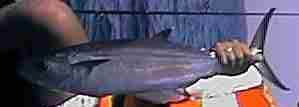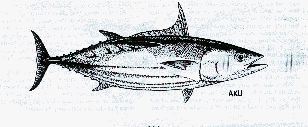- Catching
skipjack tuna is a good way to begin to learn about the sport of trolling. Skipjack tuna
puts up a good fight. They can be caught on very light tackle. And fishing action is often
fast enough to keep beginning fishermen from getting bored. What’s more, when
skipjack tuna are plentiful, there’s room to make mistakes without anyone getting too
upset if a fish is lost.
- The
skipjack tuna or aku (Hawaiian name) is found in Hawaiian waters all year around,
but you are most likely to catch it when the big schools arrive during the late spring and
summer months. Some places, like the area of Ke-ahole Point along the Kona Coast, are home
to large schools that are almost always around when the current is right. The fish
aggregating buoys are also good places to find aku.
- Most aku are
between 3 and 6 pounds in weight. The biggest ones reach about 40 pounds.
- Aku are handsome
and sporty looking fish. Their bright silver sides flash in the sun when they strike a
lure. Dark blue stripes on their bellies give them a racy look. The deep and brilliant
blue of their backs blends well with the color of the sea, making them hard to spot in the
water. When aku are excited, their sides shine with light pink highlights.
- Your first clue
that aku are around is usually a swarm of black birds. These are called terns or, in
Hawaiian, noio. If you see noio flying steadily along without stopping it may may mean
that the aku are somewhere around but the noio haven’t found them yet either. When
noio find aku, they swarm above them in a pack. When you see them off in the distance, the
birds look like they are shuttling back and forth from left to right. They are actually
circling above the school.
- When the aku
chase small bait fish up to the surface, the noio pounce on the bait fish as they try to
escape along the surface. The birds beat their wings rapidly to control their flight and
swoop down to the surface. Under them, you’ll see the splashes of feeding aku.
- If your boat is
the first on the scene, you should have little trouble catching aku. If, on the other
hand, other boats have run back and forth through the aku school, the fish become
frightened and dive down when they hear a boat coming. At such times, they are very hard
to catch. Sometimes they frighten easily even when other boats are not around.
- The secret of catching
aku is to borrow a rule that trout fishermen follow: fish fine and far off. This means to
use a small lure with a very light leader and to put the lure very far behind the boat. It
also helps to circle the school, keeping the boat away from the fish while you are pulling
your lures through the school.
|



